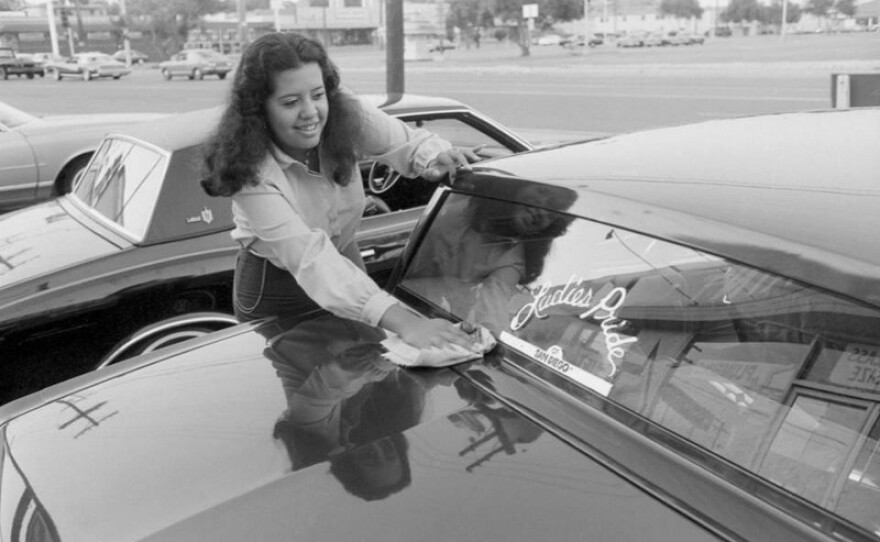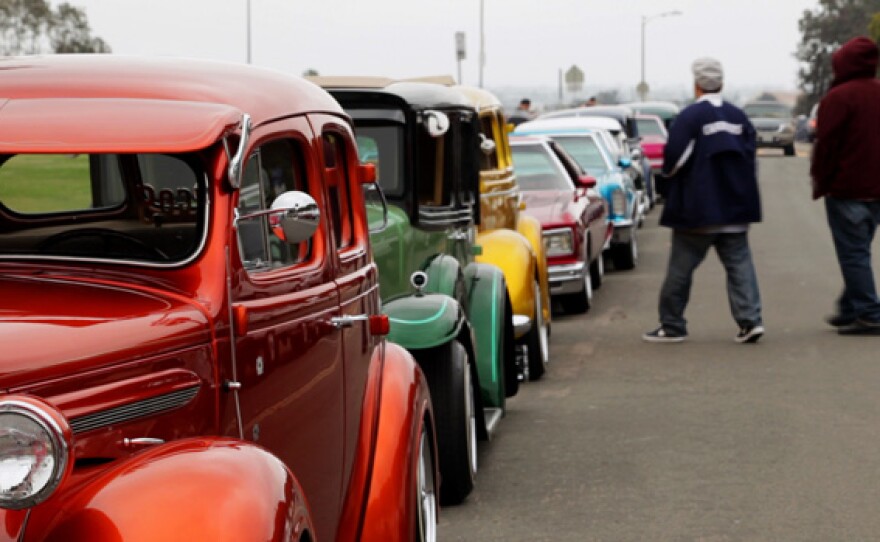This is KPBS Midday Edition I am Maureen Cavanaugh. Lots of people will be headed to Chicano Park is looking for's 47th anniversary celebration. Visitors will be commuted and taking the bus or trolley or walking to the park but a special group of anniversary guest the arriving low and slow. Low riders will line the streets as part of the Chicano Park celebration. They will hold a place of honor as icons of the Southern California pop-culture movement that has never really gone away. Joining me are Alberto Lopez the chair of the equity -- ethnic studies. Also here is recovery is founder of the amigos car club. Both of them are co-authors of the new book the San Diego low riders a history of cars and cruising. They also directed and used the low rider documentary everything comes from the streets. 's overriding culture started back in the 1950s. During the 1950s what happens in our country that people are returning from the war there is resources available in the idea that that is actually a national movement is the idea to customize vehicles and transform them and change them. What we see in the dominant culture is cars that are fast and mean. Muscle cars and big tires and any community we came forward with the opposite of that when resources were available the cars to that being high were low and instead of being fast they were slow and that is really what caught on and to this day what relates to the traditional the right amendment that is what it is about. What characterizes a low rider. Obviously it is been close to the pavement that you need a certain kind of car or certain kind of organ -- ornamentation. Particularly the Chevy is popular and traditional and the community. The reason for that and the folks start coming back after World War II that is a sickly what they can afford. Chevy was very popular Do you expect agree on that. I agree that there is a debate and that perspective. There's always a debate whether it started in LA or San Jose and is probably the last 20 years or so it is the low rider capital of the world and again it is to be debated. I will add what is being done with the writer here in San Diego is we have been able to document is a very unique experience. They also documented car? I don't know much about that but I will throw those things that is what our contributions will be in San Diego. What attracted you to my writing. I saw my first low rider when I was 10 or 11 years old and San Ysidro California and it was in 1957 Chevrolet and for the first time when the guy hit the switch those hydraulics were barely coming into the scenery hits the switch and hit the floor it blew my mind and I fell in love and that minute and it really attracted me Is for writing a thing of the past or has it taken off X It's taken off with younger generations and has become an international phenomenon. They recently went to Japan a part of one of the largest commercials of the world. You have low riders from Germany and Brazil and all over the world. Has taken off and what came from the community and the neighborhood has now made it an international phenomenon. Was part of the entourage that went to Japan. It was totally mind blowing. I was pretty impressed and I was honored to be a part of that. The approach is very respectful towards our culture. I felt like we were being used or copycatted and it gives honor and respect as we know it. This is the first time Tijuana car clubs are going to be involved in the low rider exhibit. In the past we have had maybe very isolated instances were one or two people will participate. In this particular instance will make it a point and we are having 15 -- delegation of 15 different car clubs that are being represented from across the border. For us it's a very special occasion and one of the reasons we were able to do it is because we were funded by the national Association of the arts and cultures. They helped us sponsor and cover some of the cost across the border. For them it is -- the reality is that the economy even though we are only 20 miles away from their they are limited in the resources. For them it was a big help and also selecting real people that could actually come across the border was another issue. You will be participating in a book signing tonight and I know that you both produced the documentary on Laredo culture in San Diego a few years ago. Why did you feel it was time to put all the history into book form of. The first thing is we were contacted by Arcadia press which is in South Carolina. They had seen the film and were very moved by it and their focus is on local history. The asked would reveal willing to write a proposal. Long story short the proposal was done and over of the delight to work with. So what we did with much support and much guidance from Rego is we interviewed 27 car clubs and we took their archives and we were able to get permission to use these images and so the photo is filled with so much history and basically is an early history of low rider culture probably 1965 to about 1980. We discovered the first low rider in San Diego who grew up in old town. It was amazing. We were just so moved by this project. I want to let everybody know I have been speaking with Alberto Lopez and Rego Reyes. They will both be at a book signing event for their buck San Diego low riders a history of cars and cruising that is tonight at red insult and barrio Logan starting at 6 PM. Thank you both for coming in. Thank you.
Book Event
When: Tuesday, 6-8 p.m.
Where: Bread and Salt in Barrio Logan
Cost: Free

Chris Cano grew up surrounded by the lowrider car culture. But in the 1980s, San Diego’s lowriding scene was dominated by men and women were not allowed to join car clubs.
So, she took matters into her own hands and formed the first women-only car club in San Diego.
"Ladies Pride Car Club" was made up of young women in their early twenties who were working and going to school. Their customized cars were a symbol of independence.
Like many other car clubs at the time, they would cruise down Highland Avenue in National City and hang out at Chicano Park.
The story behind the "Ladies Pride Car Club" is just one of many chronicled in a new book on the history of the lowrider car culture in San Diego County.
Related: San Diego’s Lowrider History Documented
“San Diego Lowriders: A History of Cars and Cruising” documents the roots of the movement, from its birth in the 1950’s, to its heyday in the the 80’s and present day.
San Diego’s lowrider scene will be on full display this weekend during a car show at the 47th annual Chicano Park celebration.
Alberto López Pulido and Rigo Reyes, who co-authored the book and produced the documentary, "Everything Comes from the Streets", discussed lowriding culture’s past and its future Tuesday on Midday Edition.






